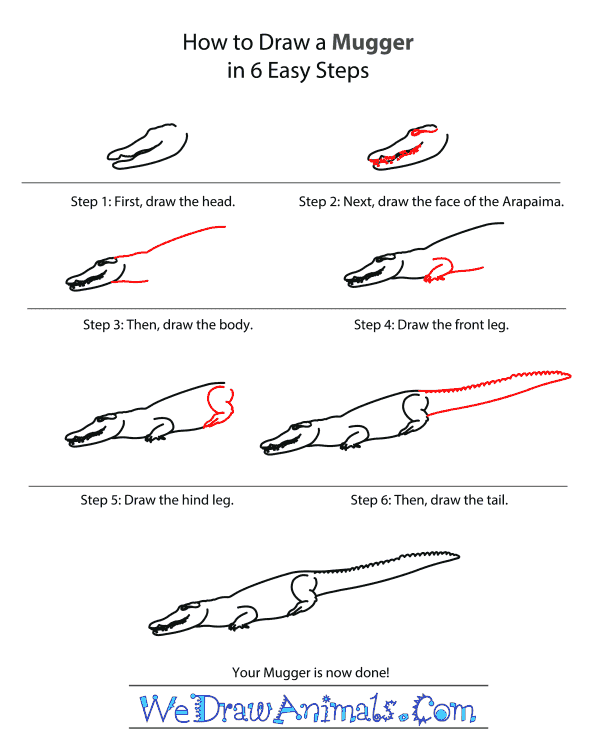In this quick tutorial you'll learn how to draw a Mugger in 6 easy steps - great for kids and novice artists.
The images above represent how your finished drawing is going to look and the steps involved.
Below are the individual steps - you can click on each one for a High Resolution printable PDF version.
At the bottom you can read some interesting facts about the Mugger.
Make sure you also check out any of the hundreds of drawing tutorials grouped by category.
How to Draw a Mugger - Step-by-Step Tutorial
Step 1: The first step for drawing the mugger is to draw the head with its mouth open.
Step 2: Now, draw the face with teeth and eye with a long eyelid.
Step 3: The next step is to draw the body but leave the belly space open.
Step 4: Then, we are going to draw the front leg. The front leg has an elbow area that is close to the body and then add a small line for the belly area.
Step 5: Now, draw the hind leg it also has an elbow area that is close to the body.
Step 6: Finally, draw the tail. The tail has several ridges along the top and goes to a point.
Interesting Facts about the Mugger
The mugger is a crocodile. It has a flat head with its eyes, ears, and nostrils on the top. This allows the mugger to fully submerge their bodies but keep their sensory organs above water. A flat tail propels the mugger through the water. Muggers can grow to a length ranging from 4 to 5 meters. A hatchling’s length is around 25 centimeters. Young muggers eat crustaceans, small fish, and insects. Adult muggers eat fish, frogs, birds, monkeys, and crustaceans. This crocodile is found in Iran, Nepal, Sri Lanka, India, and Pakistan. It prefers shallow, calm waters. Freshwater lakes, ponds, coastal saltwater lagoons, and marshes are some of the places where the mugger lives.
Did you know?
- Crocodiles have a large and visible fourth tooth. This tooth is not present in alligators and is a way to tell an alligator and crocodile apart.
- The eyes of the mugger are protected by a clear third eyelid for underwater vision.
- This crocodile is able to cover their windpipe with a flap of skin allowing it to attack prey underwater without allowing water to get into their lungs.
- Females lay about 10 to 48 eggs each year. Incubation lasts from 55 to 75 days.
- Hatchling sex is temperature dependant. Eggs incubated at 32.5 degrees Celsius result in males; eggs incubated above or below 32.5 degrees Celsius result in females.
Lesson plan note: Draw a large picture of the mugger. Make copies and distribute to each child. Have the children use markers, crayons, or colored pencils to color their crocodile. Write the name of each child on the back of their picture. Then, hang each mugger on the bulletin board for everyone to see. If you are able, visit your local zoo to see crocodiles and alligators up close!







